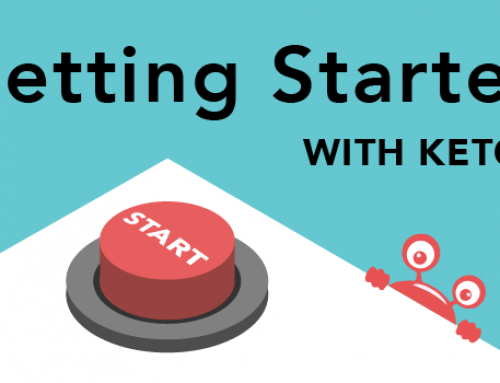Still not sure about what foods you should eat in keto? Here’s a primer on what types of foods are good for you and what you should avoid.
This is a quick look into what you’ll be eating and not eating, but keep in mind, it isn’t an exhaustive list. The best way to understand the nutritional content of any food is to look it up.
My go-to research method is my phone app, which references several domestic and international nutrition databases. Your’s may also be an app, or Google, whatever works for you, just be sure it’s a reliable resource.
There will be adjustments made later to your personal CustomKeto plan based on your individual needs, but that’s the second step, first let’s look at some basic types of good and not so good for you foods.
Some items will be familiar while others will sound completely alien – just skim over the food you don’t recognize, they’re probably regional.
If you’d like a printable reference version to keep in the kitchen drawer next to your Scale of Honesty, get it here.
Let’s start with some major food groups:
What you will be eating:
Fats – Ah, fat – the magic key to your success! This is the most important macro in your plan! Once you know how many grams of fat you need to hit per day, you really have to push yourself in the beginning to get them. It’s not as easy as you think!
But not just any fat, strive to get the best quality fat you can.
Saturated Fats are great, you’ll find them in cream, eggs, coconut oil, red meat, lard, and more. They have a long shelf life, a high smoke point, and are very stable. You’ll use them for most of your cooking.
High-Heat Oils/Fats – Sizzle These
Butter, Grass Fed
Ghee, Grass Fed
Cocoa Butter
Coconut Oil
Duck Fat
Goose Fat
Lard and Pork Fat (bacon)
Tallow, Grass Fed Only
Unsaturated Fats are also good, just don’t use them for high-heat cooking. Once heated, they become oxidized and can cause inflammation in the body. Use these for for added flavor/finishing.
Cold/Low Heat Fats – Drizzle these
Almond Oil
Avocado Oil
Extra Virgin Olive Oil
Fish Oil
Flaxseed Oil
Hazelnut Oil
Krill Oil
Macadamia Oil
Peanut Oil
Sesame Oil
Walnut Oil
Other Fun Forms of Fat:
Mayonnaise
Coconut Butter
MCT Oil*
Fatty Fish
Avocados
Egg Yolks
Macadamia/Brazil Nuts
*You’ve probably heard about MCTs (medium-chain-triglycerides). They’ve achieved a bit of a rock-star status in the performance community, but are really just another form of healthy saturated fat found primarily in coconut oil (trace amounts in butter and ghee).
What makes them so special is that they are very readily absorbed by the body and are often used by athletes as a source of quick energy.
They’ve also been shown to offer a higher level of mental clarity – I can attest to this.
They can be used many ways, but are most famous as an ingredient in bulletproof coffee.
But beware, MCTs can cause an upset stomach at first, so ease into it with a half tablespoon at a time. They can be found online or in health food stores (be sure you’re getting a good quality brand, there are many levels of MCT purity).
Remember that all fats are not created equal. There’s a list of harmful fats at the end of this post in the “What not to eat” section.
Veggies (except starchy ones – see below)
Bamboo Shoots
Bell peppers
Bok choy
Broccoli
Brussel Sprouts
Cabbage
Cauliflower
Celery
Chard
Chives
Collard Greens
Endive
Green beans
Kale (dark leaf)
Kohlrabi
Lettuce – go for colorful lettuce
Mustard Greens
Radicchio
Radishes
Spaghetti Squash
Spinach
Swiss Chard
Turnips
Zucchini
And so many more not listed! When in doubt, go with vegetables that grow above ground. While not always a hard and fast rule, it’s generally correct (for example you want to avoid potatoes and carrots, but onions are okay in moderation).
Friendly Fruit:
Avocado
Capers
Coconut
Cucumber
Eggplant
Lemons
Limes
Olives
Tomato
Protein – Remember, protein should be consumed moderately since it can be converted to sugar if you go overboard. Stick to your macros.
Go for high quality meat (organic, grass-fed, pasture raised, or wild caught). If you can’t go organic, don’t sweat it for now, the most important thing is to get started.
Fish (the fattier, the better)
Anchovies
Bass, Freshwater & Saltwater
Butterfish/Pompano
Catfish
Chilean Sea Bass
Cod
Flounder
Grouper/Sea Bass
Halibut
Herring
Mackerel
Mahi-mahi
Salmon
Sardines
Snapper
Swordfish
Trout
Tuna
Whitefish
Shellfish
Abalone
Clams
Crawfish/Crayfish
Oysters
Lobster
Crab
Scallops
Mussels
Squid
Beef (grass-fed, high fat/marbled cuts are best)
Ground beef, 80/20 is great, don’t go too lean
Steak: go for marbled, fatty cuts!
Brisket
Roasts
Ribs
Flank/London Broil
Pork:
Bacon (check label for hidden carbs)
Ground pork
Pork loin
Pork chops
Tenderloin
Pork Roasts
Pork Shoulder
Ham (check the carb content, lots of ham has added sugar)
Sausage (check the label on all sausage products)
Poultry:
Chicken
Duck
Turkey
Quail
Pheasant
Geese
Whole Eggs – organic, cage free
+ other wild game in your neck of the woods.
Dairy Products – as long as you have no allergy or sensitivity to dairy, you’re good to go. Try to go organic with dairy products since the nasty, non-organic stuff is stored in the fat, and we want all the fat!
Cheese (hard cheeses)
Cream Cheese
Full Fat Yogurt
Grass-fed Butter
Half and Half
Heavy Cream
Sour Cream
Nuts – Nuts are allowed but can be a slippery slope. Don’t use them to munch on mindlessly. Know how many carbs are in an ounce and don’t go overboard. Visual: an ounce of nuts is typically about a ¼ cup.
Almonds
Brazil nuts
Hazel nuts
Macadamia
Peanuts
Pecan nuts
Walnuts
Nut Butters – Go for natural, unsweetened nuts and try to stick with fattier versions like almond butter and macadamia nut butter. But not peanut butter, more on that later.
I love finding the one brand in the grocery store that lists only one or two ingredients on the label, which will be the nut, and then salt. There is no good reason for there to be any additional ingredients.
Drinks/Beverages
Water is always your best friend.
Carb-free Seltzer
Low carb protein drinks
Low carb smoothies
Bulletproof Coffee
Tea
My Weapons against Mass Consumption (quick appetite appeasers):
¼ cup of Macadamia Nuts
An ounce of Healthy Jerky (healthiest: make your own!)
A UPC label size of Dark Chocolate Bar (read all labels and know your serving amount)
Pork Rinds with an ounce of Jalapeno Pimento Cheese
And now…
What not to eat:
No Sugar – in all its forms: candy, cookies, soft drinks, pastries, milk chocolate, candy bars, juice, fruit (yes, fruit, we’ll talk more about that later), even more surprisingly most liquid cold medicines and cough syrups are full of sugar. You’ll have to become a tireless label reader to find the hidden sugars – because SUGAR IS EVERYWHERE!
No Unfriendly Fruit – Here we go… but fruit is good for me! Not when you’re trying to stop an insulin (fat packing) response! Steer clear of all fruit. Berries are a little different, we use them sparingly for flavor in smoothies and as toppings, but never typically more than a ¼ cup a day (which is about 4-5 grams of carbs by the way, 25% of your allowance!)
No Bread/Grains/Starches – Any flour or wheat products like bread, cake, biscuits, scones, pancakes, cupcakes, anything whole wheat or whole grain, any cereal, cereal bars, pop tarts, rice, corn, and even beer. And don’t forget pasta! That’s a big one, but don’t worry, I have a few even tastier alternatives. Also no grains like quinoa, spelt or chia seeds. No potatoes, sweet potatoes, corn, peas, parsnips, carrots, or winter squashes.
No Trans fats – Avoid at all costs – foods like margarine or shortening. Artificial trans fats (or trans fatty acids) are created in an industrial process that adds hydrogen to liquid vegetable oils to make them more solid.
Look for “hydrogenated” or “partially hydrogenated oils” in the ingredients and then dramatically throw it across the room, it is quite literally poison.
DO NOT EAT:
Vegetable Oils
Margarine
Hydrogenated or Partially Hydrogenated Oils
Sunflower Oil
Safflower Oil
Cottonseed Oil
Canola Oil
Soybean Oil
Grapeseed Oil
Corn oil
Now that you’ve got a basic idea of what you can and can’t eat (and you know to look it up when you aren’t sure), it’s time to calculate your macros and get cookin’!



